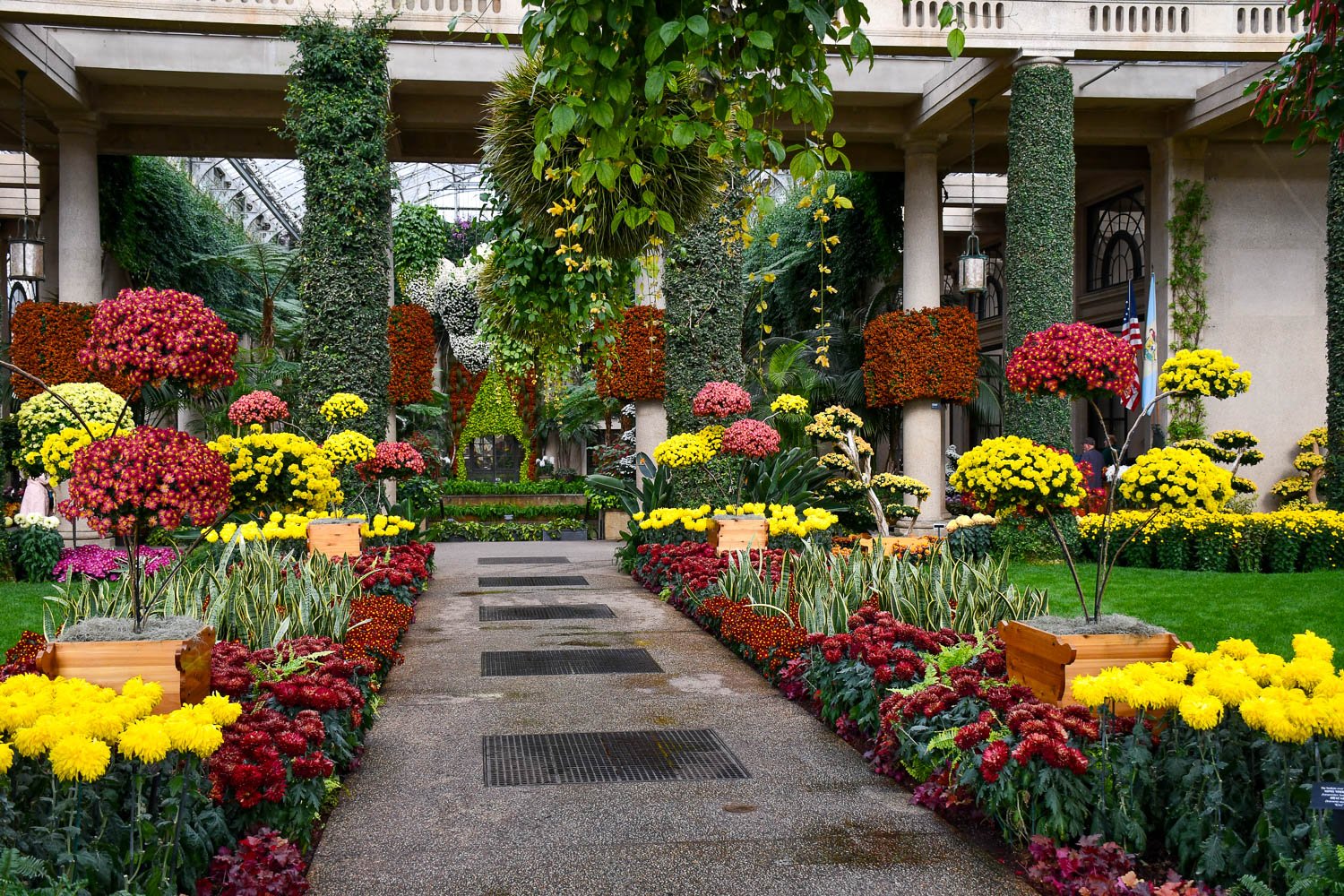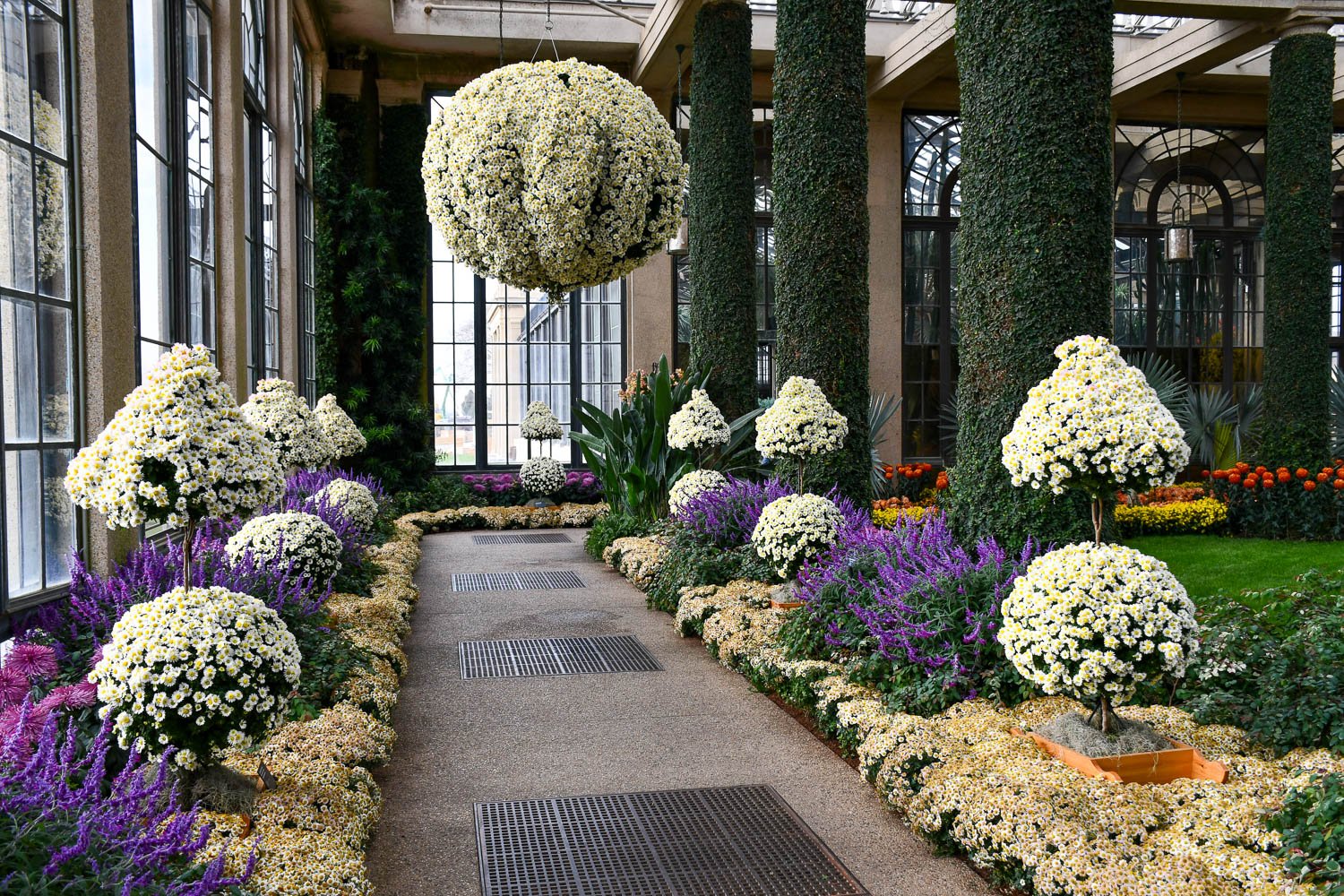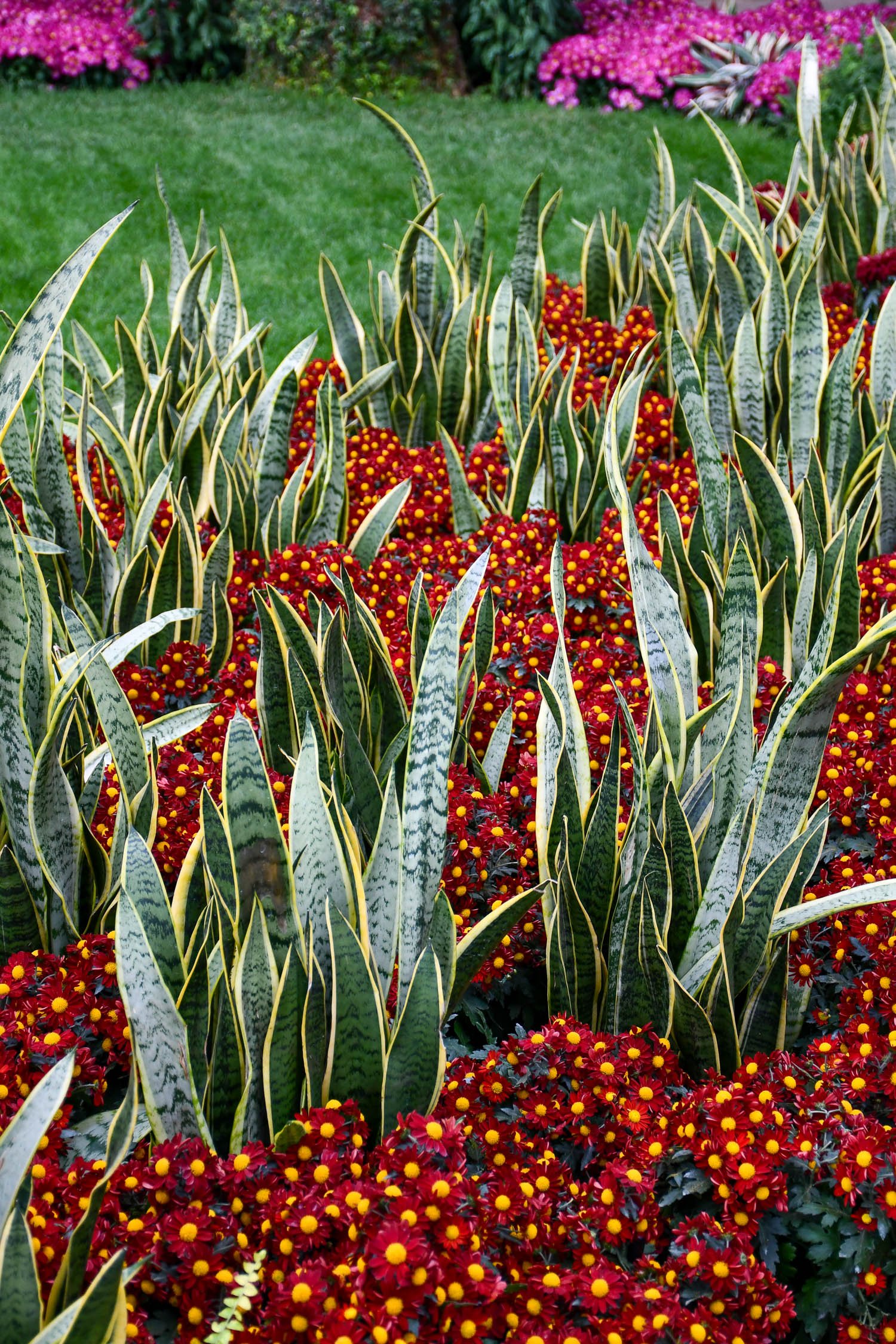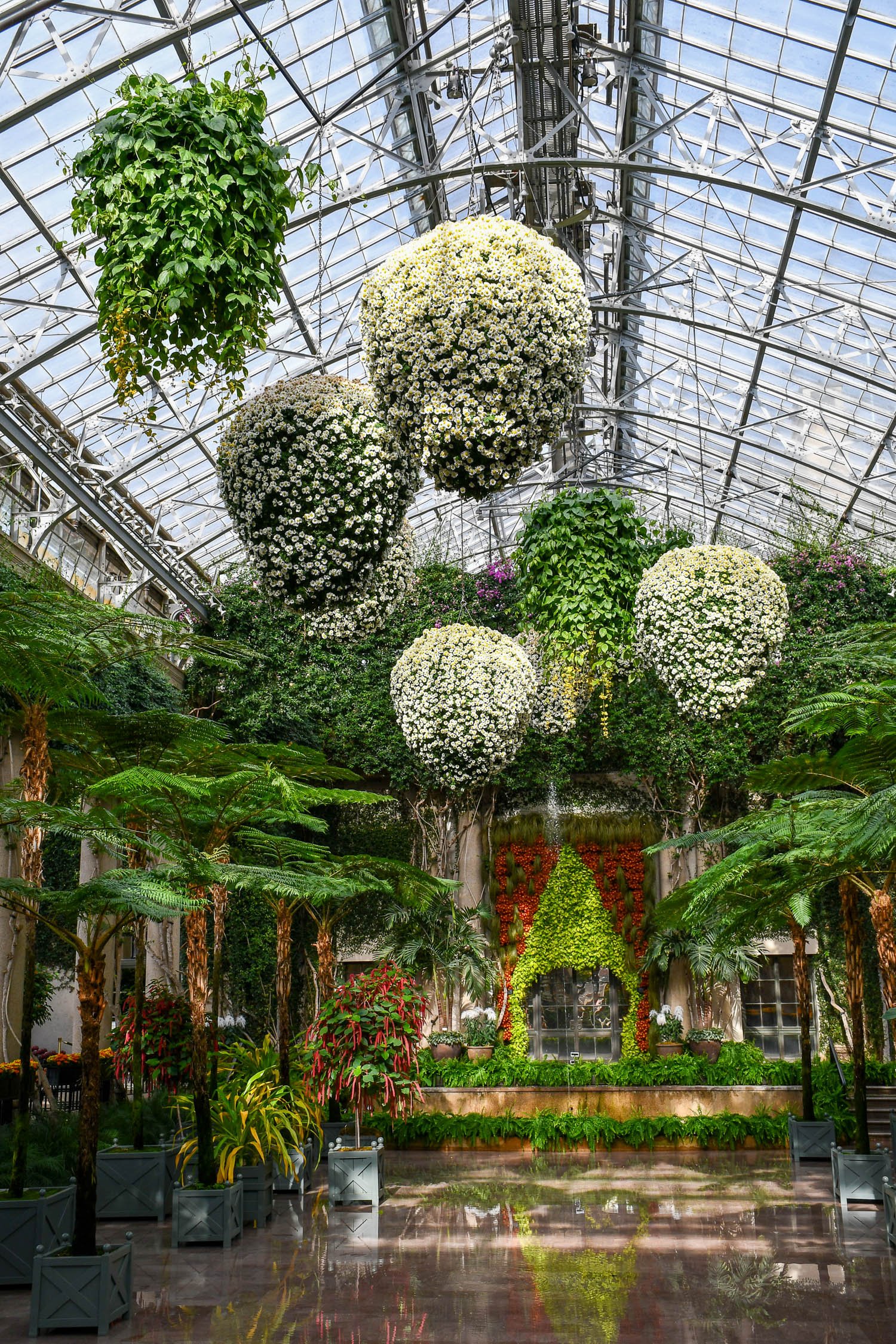I’m still processing through photos from my recent trip to Philly to keynote the Ecological Landscape Alliance’s conference Regenerative Solutions for Resilient Landscapes. I’ve already written about my visit to Chanticleer and the things that I learned there. Today, I wanted to share my visit to Longwood Gardens and Stoneleigh with you. I love these two gardens for all that they have to offer horticulturally. My only regret was that I didn’t have more time!
LONGWOOD Gardens
Since the conference was held at Longwood Gardens, I found a few gaps during the day where I could explore. Longwood’s Chrysanthemum Festival was wrapping up, but there was still plenty of beauty to see in the conservatory. This combination of the purple Salvia leucantha (Mexican bush sage) was striking with the white mums.
I finally got to experience the giant Thousand Bloom mum! I’ve had this horticultural marvel on my bucket list for a while, and I was fortunate as this year is the first year it’s back after a two year break. This specimen of ‘Susono-no-Hikari’ has a total of 1,366 blooms, stretches 12 feet, and it took 18 months to grow it from a single cutting!
We have Senna bicapsularis (winter cassia) growing on campus, but this lighter flowered form named ‘Butter Crème’ turned into a standard was striking.
The contrast between the carpet of Chrysanthemum × morifolium ‘Himegokoromo’ (mum) and Sansevieria (mother-in-law’s tongue) was so striking. I thought this could also be easily done with summer annuals like vinca or Profusion zinnia.
Chrysanthemum balls hang above this reflecting pool in the conservatory. Don’t you just love the wall of plant tapestry beyond?
I made my way down to Peirce’s Woods to enjoy some of the fall color of Longwood. This mass of Deschampsia cespitosa (tufted hairgrass) was a nice foil for the colors of Cornus florida (flowering dogwood) and Hydrangea quercifolia (oakleaf hydrangea) to pop against.
The seeds of Halesia diptera (two-winged silverbell) glow like ornaments against a hazy sun.
I always chuckle seeing Eupatorium capillifolium in gardens because it is a weed around my house. But, what a spectacular weed it is! This selection is appropriately named ‘Elegant Feather’.
I swooned over these Sarracenia (pitcher plant) bowls near Pierce’s Woods. They had such a wild yet formal look to them.
STONELEIGH
The next day I made my way to Stoneleigh with Steve Foltz after we visited Chanticleer. Stoneleigh is a young garden that is building quite the reputation for its focus on natives. I’ve covered it in previous posts during visits in June and August, and I interviewed director Ethan Kaufmann on The Plantastic Podcast. But, having never visited it in the fall, I was excited to see what treasures the garden held at the end of the growing season. We were fortunate that Lead Horticulturist Eloise Gayer gave us an engaging tour of the grounds.
Looking up towards the house at Stoneleigh we enjoyed the fall color of Rhus scattered about.
When I visit gardens, I keep my eyes peeled for good color combinations, even if the plants are not close. For example, these fuschia-colored fruit on Symphoricarpos orbiculatus (coralberry) were a glorious color. Then…
…when I got near the house, I noticed these Opuntia humifusa fruit glistening with rain. I didn’t recognize the color echo between the two until I got home and started going through photos. That’s the benefit of taking many and processing them after a trip!
‘Tis the season of the witchhazels, and Hamamelis virginiana ‘Green Thumb’ was in full bloom. I always admire these plants that hug the end of the gardening year. Is it the end of one growing season or the beginning of another?
I have longed to be able to grow some of the heat-sensitive Acer pensylvanicum (striped maple) in the deep south, but I’ll have to settle for seeing them when I travel north. The orange-red stem color of ‘Erythrocladum’ with these bleaching yellow leaves were a nice analogous pairing.
While they can look a little ratty due to the faded pitchers of the growing season, my favorite time to see Sarracenia is in autumn when many species produce fresh fall pitchers. The colors on them seem even more vibrant than when they first emerge in the spring.
Near the bogs, these Aronia arbutifolia (red chokeberry) were loaded with fruit. Ethan shared with me that this selection seems to be heavier fruited than others in the trade.
I can now say that I have seen a Baccharis halimifolia (sea myrtle) hedge! The white pappus added a nice effect to the tapered plant. On the right was another native that generated some discussion while I was visiting Philly gardens—Helianthus argophyllus or silver-leaf sunflower. The leaves feature a gorgeous silver pubescence, and then in autumn the plant is loaded with flowers.
We just had to stop and admire the twisting, sinuous bark of this Thuja occidentalis (eastern arborvitae). Eloise told us this specimen was one of her favorite plants at Stoneleigh.
When I visit Stoneleigh I’ve delighted to see cultivars of native plants I never knew existed. This garden was the first place I ever saw the weeping Cladrastis kentukea ‘White Rain’ (yellowwood). The fall color was just starting to show.
My first time experiencing fall color on Franklinia alatamaha (franklinia) was this trip to Philly. I had heard it turned a brilliant red, but I had never experienced it for myself.
And, even after the leaves fall, Franklinia leaves are blood red. The rain helped saturate the color.
At first, I thought this groundcover was native Pachysandra (pachysandra), but upon closer inspection I was delighted to see a thick carpet of Phacelia bipinnatifida (fern-leaf phacelia). In another correspondence, Ethan shared with me that this ruderal makes a great groundcover before flowering in the spring and going to seed.
And one last photo showing the new lovely water feature in Catalpa Court.































































































